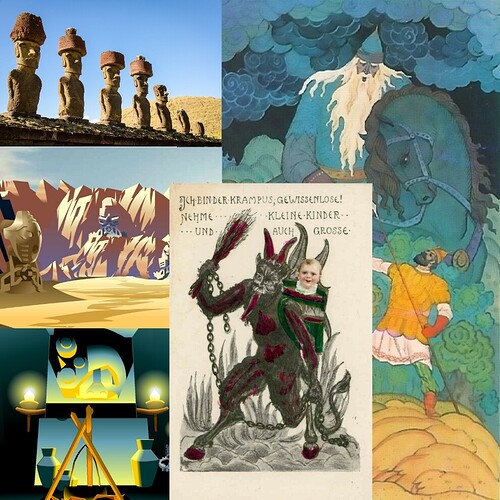Here I want to discuss loosely some of the details from real life mythology and folklore that seems to be an inspiration for Bionicle own lore. It’s going to be my assumptions, of course, however many of them really speak for themselves. We’ll start with earlier story and then proceed to postretcon area.
2001
With 2001 lore I really can’t do much more than summarizing Mister N’s blog in case you didn’t read it or forgot what it was all about.
First of all, the ”Masks of Power” card game and a few catalogs give us an impression of an initial idea to make Toa actual deities, forces of nature rather than heroes. Tahu was making magma flow into the ocean to Gali’s displeasure, while Gali was fighting Leva which resulted in storms over the island. That really seemed like direct borrowing of spirits of nature concept common among many Polynesian cultures. Interestingly, in MNOG we can see stone masks of Toa everywhere which really makes you think of worshipping of deities.
Papa and Rangi, that are briefly mentioned in MNOG, are credited by Nokama as those who established villages on Mata Nui. Those are the names of Māori gods of sky and earth, which bestowed a valuable knowledge upon people. Could their intended role be similar in Bionicle?
There’s a half-humorous exposition in Po-Wahi ”made by ancient carvers” — a bunch of
Tohunga heads made of stone with stone masks of Toa Mata placed on them. It’s a reference to mysterious statues from Easter island — stone heads with stone slabs put on them like those are hats. No one knows for sure what was the actual cult around them. Yes, because this is ”the work of ancient carvers” now.
Makuta, name of force behind all the evil on Mata Nui, is derived from a word ”makutu”, which roughly stands for witchcraft. It is the type of curse that can be placed on a man by reading a spell with a tip of tongue. It brings inevitable death, though knowledgeable person could reverse the curse effect on caster. Interestingly enough, there’s also a term ”tohunga-makutu”, which means an expert in sorcery. And we all remember the tohunga form of Makuta.
Speaking about tohungas, the word means ”priest and expert”. There are many types of tohungas in Māori culture, among them:
-
t matakite — foretellers of the future;
-
t. whakairo — expert carvers;
-
t. raranga — expert weavers;
-
t. tātai arorangi — expert at reading the stars;
-
t. kōkōrangi — astronomer;
-
t. tārai waka — expert canoe builder;
-
t. wetereo — expert in the language.
All those professions are actually present on Mata Nui, so you can say every Tohunga was an expert at something important.
2003
Rahkshi are a group of six warriors, every one in direct opposition to moral principle of one of the six Tohunga tribes, for example, Anger being opposite of Calmness. This is pretty close to an image of daevas in folklore of Zoroastrianism — six demons lurking in darkness, created by evil spirit as opposition to ”angels”, who come from benevolent spirit of creation. There are six daevas, each brings his own evil. Among them:
-
Indar that freezes minds of righteous (as with fear);
-
Tauriz, demon of destruction;
-
Zariz, who poisons plants;
-
also Xeshm of wrath.
See the parallels?
The concepts of light as something reliable, close to a man, and darkness as symbol of unknown and dangerous is also present in Maōri mythology. The fusion of them in the end of ”Mask of Light”, however, seems to be a symbol of necessity of both in the world.
2004
Metru Nui also borrows a bunch of things from mythology, now greco-roman, with stadiums and throwing disks. But first of all it represents the promised land for Mata Nui Matoran, as Takanuva leads them here after death and rebirth, widely known Biblical plots.
Metru Nui has a Coliseum with a statue of Toa Lhikan, maybe as big as the Colossus of Rhodes was — the statue of god Helios. Now the monument of Toa of Fire. Another characteristic detail is prophecy made about six new Toa coming. In Greek world oracles that could communicate with deities and gave accurate predictions was a widly acknowledged respected occupation, and here it’s central to the plot.
There’s also a curious Rahi-Nui beast which also appeared during earlier ages of series. It resembles mythic manticore with scorpion stinger and lion’s body, but instead of human’s head it has Kane-Ra head. Also it has wings, so most likely it is ”Dungeons & Dragons” late days idea of manticore.
2006-2008
Surprisingly mythological inspiration continued to be relevant for Bionicle during its more sky-fi-ish years. For example, Hand of Artakha as a group of powerful wild heroes that was disbanded in favor of more disciplined Toa is a very common motive in folklore. It symbolizes a victory of cultured heroes in minds of people over more primitive images of wild nature forces, barely tamed. Good example is the story of Russian hero Svyatogor who has to accept his death in favor of new generation, but tests a younger hero Ilya Muromets before handing over to him a part of his powers.
Toa Helryx also is a figure influenced by mythology. She has many similarities with maternal deities of water in many pantheons, for example Tiamat. She is the first, primordial Toa. She controls Water, and is able to destroy whole fleets by herself. She is a fierce warrior. She also is a ruler in her own right. All of this can be said of Tiamat.
The opposition of realms of Artakha and Karzahni is a pretty obvious reference to afterlife picture in Christianity. Greg Farshtey confirmed that he wanted Karzahni to feel like ”Dante’s Inferno” (though dustfalls may come from different traditions of underworlds, Mesopotamian or Jewish folklore for example).
The rulers of those lands on the other hand look a lot like St. Nicholas (aka Santa Claus) and his counterpart, devilish Krampus. Karzahni has horns, and carries chains — like Krampus does. He also punishes Matoran for bad behavior (as Krampus sometimes was carrying kids to Hell). Artakha in contrast gives righteous Matoran a chance to work in a safe haven, and even makes ”gifts”: you can leave materials at his gates and expect them later to be turned into what you desire to be made.
Finally, there’s a coincidence in Hawaiian mythos with Tren Krom, which may seem pretty random, yet it’s interesting. During the creation of the world in the times of darkness the only one that remained of many first creatures was an octopus. He saw land raising from the sea on a pile of slime from the dead fish. So did Tren Krom, organic being with tentacles, govern the universe when it was dark and islands were being built.
I can’t say much about 2009-2010 story. It has messiah vibes, a bunch of mysterious things with Great Beings, but more or less it’s original stories. So I’ll end it here. Hope you enjoyed.




